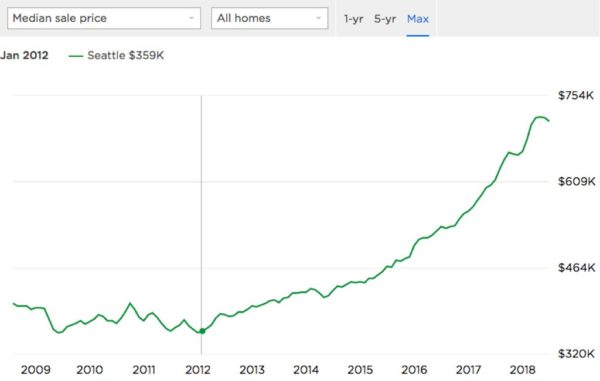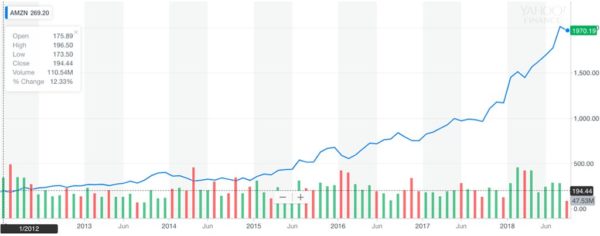This regularly-scheduled sponsored Q&A column is written by Eli Tucker, Arlington-based Realtor and Rosslyn resident. Please submit your questions to him via email for response in future columns. Enjoy!
Last week, I published Part 1 of my opinions on why Amazon HQ2 is likely to come to the Northern Virginia/Washington, D.C. region and this week I am adding my thoughts on where I think they will/should locate and (sort of) answering the most common question I get — how it will impact the housing market.
Amazon Shouldn’t Pick One Location
The popular choice for Amazon’s second headquarters in Northern Virginia seems to be Crystal City for a number of reasons including immediately available office space, proximity to National Airport (DCA) and Government, Metro access, a well-educated population and more. While I do agree that Crystal City is the best primary location for HQ2, I hope they take advantage of the entire Northern Virginia — Washington, D.C. — Maryland region to prevent overloading the infrastructure (specifically schools and traffic) and housing market in a single jurisdiction.
According to the RFP, Amazon spreads 8.1M square feet of office space across 33 buildings in Seattle, so I would expect a similar make-up for HQ2 (projecting 8M square feet of office space).
Amazon can distribute these offices from Arlington County to Loudon County in Virginia, K St. to Congress Heights in Washington, D.C. and Montgomery/Prince George’s County to Baltimore in Maryland. They can also benefit from Metro/Commuter Train connectivity between every site, frequent domestic and international flights within 30 minutes, shipping ports, data centers, a diverse and educated workforce, affordable and diverse housing options and almost everything else that they mention in their Key Preferences and Decision Drivers.
Based on conversations, news articles and personal opinion the following locations are where I think Amazon should spread its 8M sq. ft. of office space for HQ2. I highlighted the locations I think should have the largest concentration of Amazon jobs.
Northern Virginia
- Crystal City/Rosslyn-Ballston (majority presence)
- Tysons
- Reston
- Loudon One
- Richmond Highway (Alexandria)
Washington, D.C.
- K Street/Foggy Bottom
- D.C. Armory/RFK Stadium
- Anacostia/Congress Heights
Maryland
- College Park/Greenbelt
- Bethesda/Rockville
- Baltimore (City)
All of this can be done to strategically improve local economies and infrastructure without the devastating effects of adding 50,000 jobs to one or two locations. Plus, Amazon already has enticing incentive packages from all of them!
The Impact to the Housing Market Will Be…
Everybody wants to know how much home values will rise and how quickly… and it would be irresponsible of me to answer that question. Until we know how the jobs will be distributed, how they’ll hire (local vs. new residents), the timeline and the types of jobs then there is no basis for quantitative analysis. However, I’ll share some thoughts that may help answer some of your questions…
If the announcement is made in favor of Northern Virginia or the D.C. Metro, I believe we will witness two opposing market forces at play:
On one side, prices will push upward as sellers demand a premium for being part of the new Amazon market area and buyers are eager to purchase before the wave of Amazon employees. In direct opposition to price appreciation will be a significant increase in homes for sale because many home owners are waiting for a decision before putting their house on the market. If you plan to buy or sell in the wake of Amazon’s decision, you’ll want a pre-decision strategy and access to daily analytics after the decision.
This is where I’ll happily plug myself and my team. If you’re a weekly reader of my columns, you’ll know this is what we do best. If you’re new to my columns because of the click-power of an Amazon HQ2 article, here are two recent examples (one and two) of custom, hyper-local data analysis. Personalized analytics is a pillar of our service offerings.
Ultimately, I think price appreciation will win out because the market is already hungry for more supply, but the appreciation will be limited until the demand curve shifts when Amazon’s employees, and the employees of companies that support Amazon, start buying and renting.
To get a sense of what could happen to the housing market over time, let’s take a look at the Seattle area since Amazon started taking off in 2012. Remember, with a company like Amazon, it’s not just their employees but the employees of companies with direct and indirect business relationships.
Median Home Prices Have Doubles Since Jan 2012
Amazon Stock Growth Since Jan 2012
Conclusion
As a homeowner and real estate agent, I am excited and hopeful for Amazon to select our region as the location of their second headquarters. As an Arlington resident frustrated by congestion and concerned about the impact rapid housing price appreciation will have on our community, as well as a father of a future Arlington Public Schools student, I hope that Amazon makes a conscious decision to spread their wealth across the entire Northern VA-Washington D.C.-Maryland region. We will have our answer within 100 days.
P.S. — Jeff, I’d be happy to assist your employees with their relocation. My cell phone number is 703-539-2529 if you’d like to discuss privately :)
If you’d like a question answered in my weekly column, please send an email to [email protected]. To read any of my older posts, visit the blog section of my website at www.EliResidential.com. Call me directly at (703) 539-2529.
Eli Tucker is a licensed Realtor in Virginia, Washington DC, and Maryland with Real Living At Home, 2420 Wilson Blvd #101 Arlington, VA 22201, (202) 518-8781.




